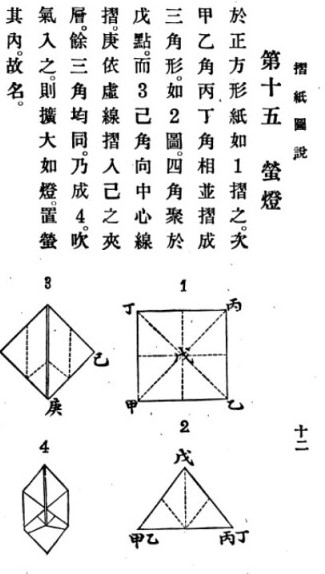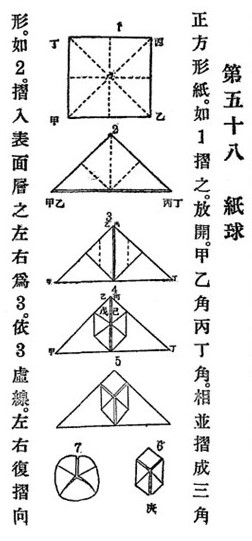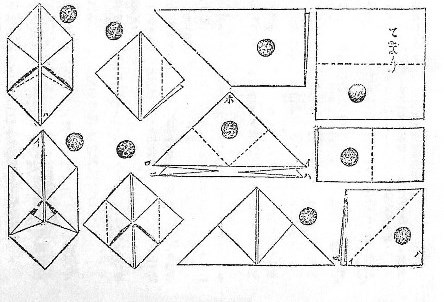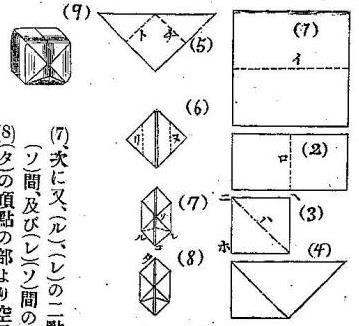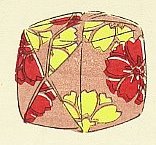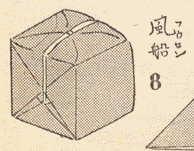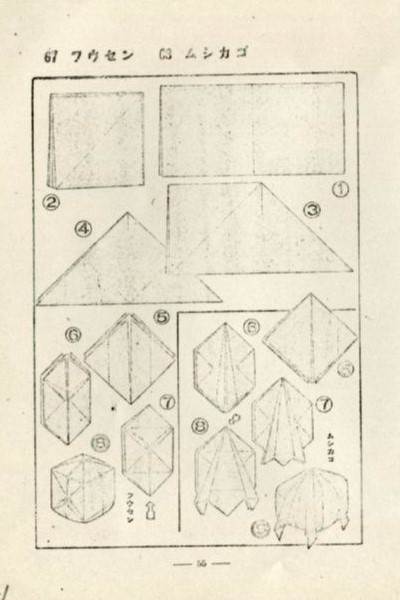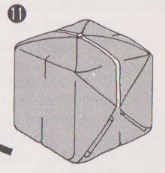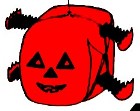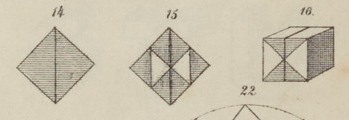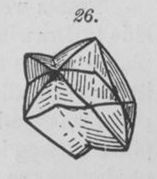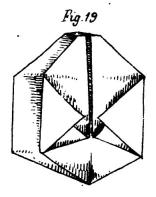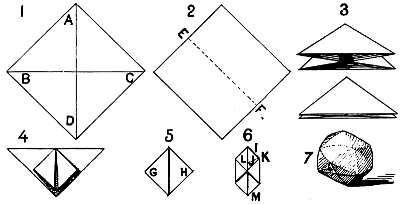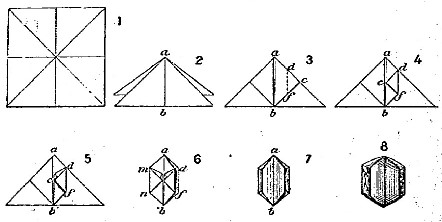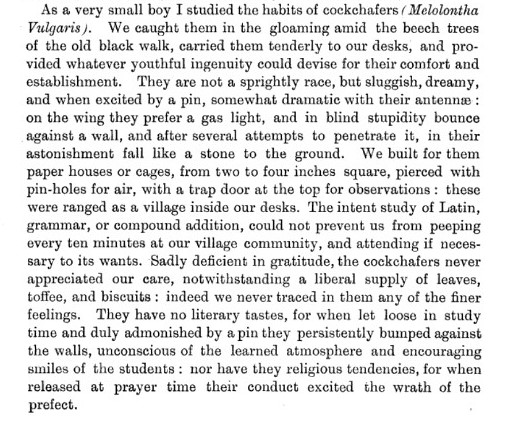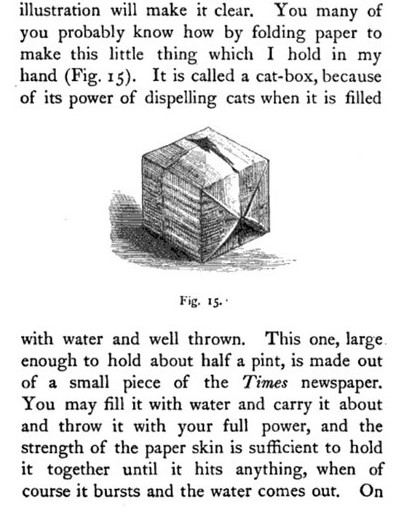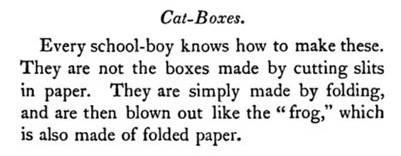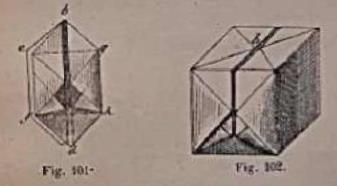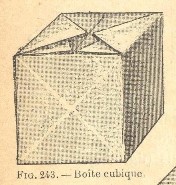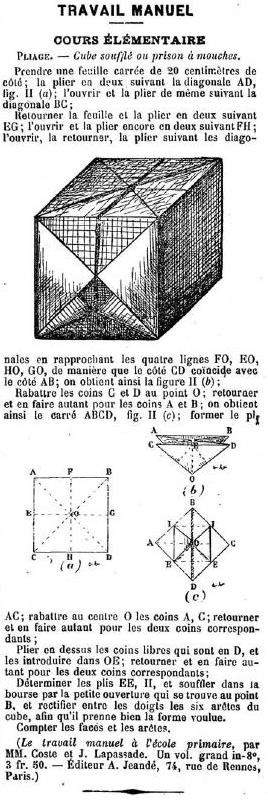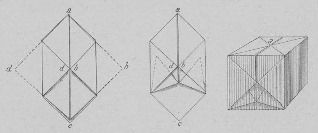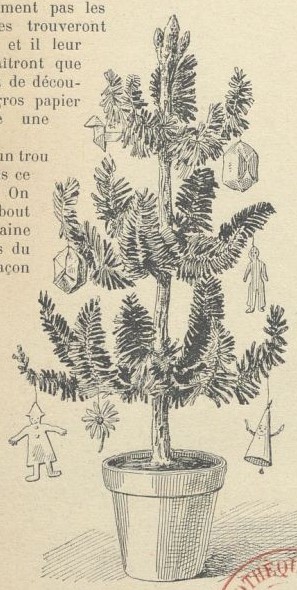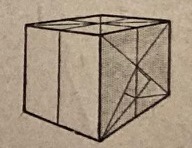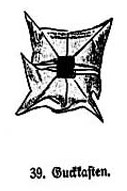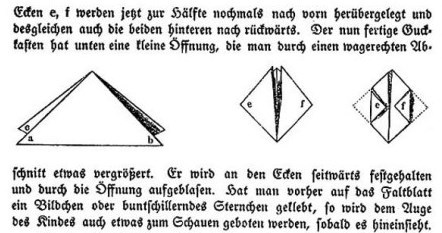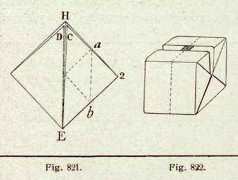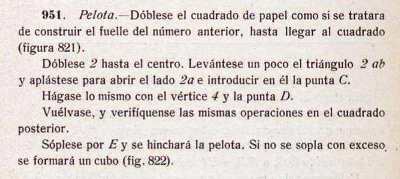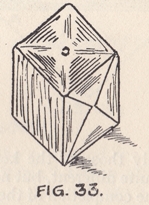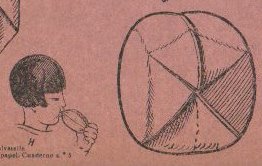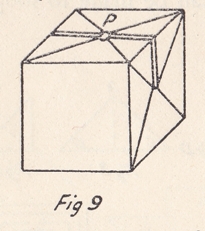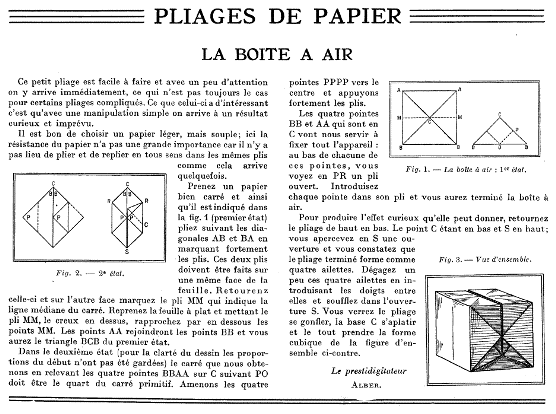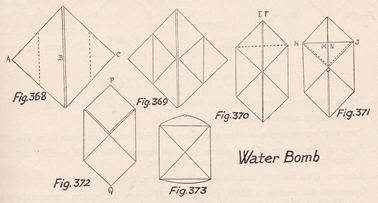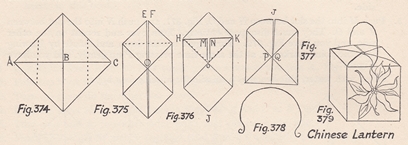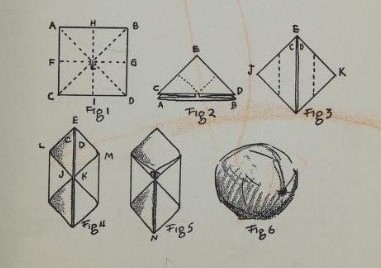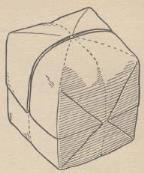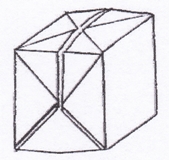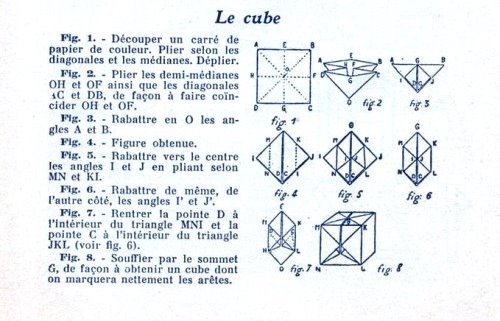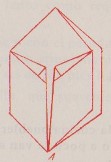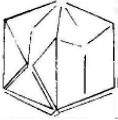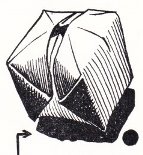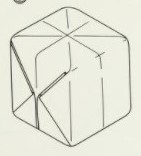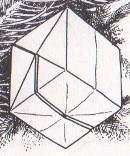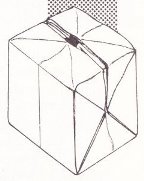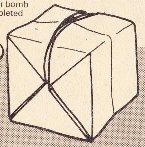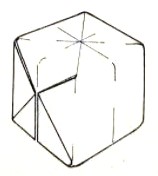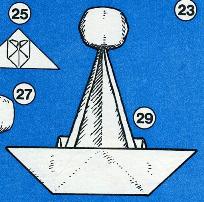| The Public Paperfolding History Project
Last updated 16/7/2024 x |
|||||||
| The Waterbomb / The Balloon | |||||||
This page is beng used to collect information about the history of the paperfolding design known as the Waterbomb the Balloon etc. Please contact me if you know any of this information is incorrect or if you have any other important information that should be added. Thank you. The name 'Waterbomb' refers to the use of this design as a water bomb in the playground by school children, but it can also be used to produce smoke rings (in a way similar to the Playing Card Cube), or as a prison for flies (whose buzzing is amplified by the container), fireflies (thus becoming a lantern), or other insects, and in other inventive ways. ********** In China (and in publications by Chinese authors) 1914 Diagrams for a 'Firefly Box' appear in 'Zhe zhi tu shuo' (Illustrated Paperfolding), compiled by Gui Shaolie, which was published by the Commercial Press in Shanghai in Ming guo 3 (1914).
********** 1917 Diagrams for a 'Paper Ball' appear in 'Xu Zhe zhi tu shuo' (More Illustrated Paperfolding) by Yongxiang Shi, which was published by the Commercial Press in Shanghai in 1917.
********** In Japan (and in publications by Japanese authors) In his article 'History of Origami in the East and the West before Interfusion', published in 'Origami 5: Fifth International Meeting of Origami, Science, Mathematics and Education' in 2011, Koshiro Hatori asserts that, ''Many of the European origami models contained in Krause-Boelte's book (ie 'The Kindergarten Guide') are not included in contemporary Japanese records. The pig, house, sofa (also known as piano or organ), balloon (waterbomb), arrow (paper plane), salt cellar (cootie catcher), bird (pajarita or cocotte) and windmill ... were all born in Europe and imported into Japan along with the kindergarten system.' ********** 1894 Diagrams for the Waterbomb, referred to as 'Temari' (ball), were published in the children's magazine 'Shokokumin' in 1894, spread over two consecutive issue (by mistake!).
********** 1908 The Waterbomb appears as the 'Balloon' in 'Origami zusetsu' (Illustrated Origami) by Sano Shozo, which was published in Tokyo in 1908.
********** 1912 A drawing of a Waterbomb appears in a monozukushi-e print, by an unknown artist, but said to be from the Meiji era. I have temporarily assigned it the date of 1912, the last year of that era, pending the discovery of more accurate information.
********** The design also appears: 1931 As 'The Balloon' in 'Origami (Part 1)' by Isao Honda, which was published in Japan in 1931.
********** 1944 In 'Origami Shuko' by Isao Honda, which was published in 1944.
********** 1965 As the 'Balloon', in 'The World of Origami' by Isao Honda, which was published in the USA by Japan Publications Trading Company in 1965.
********** In 'Origami in the Classroom: Book 1: Activities for autumn through Christmas' by Chiyo Araki, which was published by Charles E Tuttle Co Inc in 1965, Witch's Ladders are added as arms to a Waterbomb to produce a Jack O'Lantern.
********** In Europe and the Americas 1614 The play 'The Duchess of Malfi', by John Webster, first performed in 1614 and first published in 1623 contains the words, 'Our bodies are weaker than those Paper-prisons boys use to keep flies in ...' We do not know what kind of paper prison John Webster had in mind when he wrote those words. It is sometimes taken to be a reference to the design we now call the Waterbomb, which is folded from a square. This is possible, but in my view, quite unlikely at this early date. While there is evidence from the 19th century, that, at that time, Waterbombs were indeed used as prisons for flies, the paper container amplifying the sound of the fly buzzing, presumably to the amusement of little boys, we also have evidence that other kinds of paper construction were used for similar purposes. In fact, any kind of paper container, such as, for instance, a paper cone twisted shut at its open end, would act as a paper-prison in this way. ********** 1863 The first definitive evidence for the Waterbomb design, as 'De teerling' (the die), comes from 'De Kleine Papierwerkers 1: Wat men van een stukje papier al maken kan: Het vouwen' (The Small Paperwork 1: What one can make from a piece of paper: Folding) by Elise Van Calcar, which was published by K H Schadd in Amsterdam in 1863. Pictures 14 to 16 of plate VII show a very attenuated folding sequence for folding the Waterbomb.
********** 1882 Instructions for making the Waterbomb next appear in part two of 'The Kindergarten Guide' by Maria Kraus Boelte and John Kraus, which was probably first published by E. Steiger and Company in New York in 1882 where the design is called the 'Balloon' or, when made from white paper, the 'Snowball'.
'The Kindergarten Guide' also contains instructions for making a 'Spool' or 'Yarn Winder', which is really just a name for the intermediate form of the Waterbomb before it is inflated. ********** The Waterbomb also appears: 1883 As 'Lu Balluni' in 'Giuochi Fanciulleschi Siciliani' by Giuseppe Pitri, which was published by Luigi Pedone Lauriel in Palermo in 1883.
********** 1888 In a reader's letter headed 'How to Make a Paper Ball', in the Letterbox column of the March 1888 issue of the American children's magazine St Nicholas.
********** 1889 As 'Un ballon en papier' in 'La Science Pratique' by Gaston Tissandier, which was published by G Masson in Paris in 1889. The text suggests making this design from thin tracing paper and filling it with hydrogen to see it rise slowly.
********** Volume 8, Issue 3, of the 'Downside Review' for November 1889 contained a section which describes keeping cock-chafers inside 'paper houses or cages, from two to four inches square ... with a trap door at the top for observations' which, it seems to me, is a good description of the waterbomb.
********** 1890 There are reference to Waterbombs under the name 'cat-boxes' in 'Soap Bubbles and the Forces which Mould Them' by C V Boys was published by The Society for the Promotion of Christian Knowledge in London and by E and J B Young and Co in New York in 1890. The text refers to filling them with water and also says that 'Every schoolboy knows how to make these'.
********** 1891 There is mention of a 'boite cubique', which I take to be a reference to the Waterbomb, in the 'Bulletin de la Societe de Protection des Apprentis', an official document issued by the Societe de Protection des Apprentis et des Enfants Employes par les Manufactures in Paris in 1891. ********* The design also appears: 1892 As 'Cube ou prison a mouches' (prison for flies) in 'Le Travail Manuel a L'ecole Primaire' by Jully & Rocheron, which was published by Librairie Classique Eugene Belin in Paris in 1892. As far as I know this is the earliest indisputable evidence of a Waterbomb being called a prison for flies.
(Note that the flaps are not fully inserted into the pockets in this version) ********** 1893 As 'Boite Cubique ou Prison a Mouches' (Cubic Box or Prison for Flies) in 'L'Annee Preparatoire de Travail Manuel' by M P Martin, which was published by Armand Collin & Cie in Paris in 1893.
********** As 'Cube souffle ou prison a mouches' (Blast cube or prison for flies) in the 9th April 1983 issue of 'Journal des Instituteurs'. This is extracted from the book 'Le Travail Manuel a L'ecole Primaire, by M. Coste et J. Lapassade, which had been published in 1887.
********** 1895 As 'Boite Cubique' in 'Geometrie, Dessin et Travaux Manuels - Cours Moyen', produced under the direction of M E. Cazes, which was published by Librairie Ch. Delagrave in Paris in 1895. Note the way in which the flaps are inserted into the pockets.
********** 1898 As a lantern in 'Travaux Recreatifs Pour les Enfants de 4 a 10 Ans' by Marie Koenig, which was published by Librairie Hachette et cie in Paris in 1898. The text suggests using a paper cone to help young children inflate it and also the possibility that young children need not tuck the flaps inside the pockets. It is also worth noting that the writer refers to the upside down waterbomb base (fig 2) as 'le double bateau' (the double boat). Waterbombs also appear as decorations on a Christmas Tree.
********** 1903 As 'La Boite Fermee' in the 21st February 1903 issue of the French children's magazine 'Mon Journal'.
********** 1908 As 'La boite fermee' in 'Les Petits Secrets Amusants' by Alber-Graves, which was published by Librairie Hachette in Paris in 1908.
********** 1910 As 'Guckkasten' (peep box) in Part 2 'Das Flechten' of 'Die Frobelschen Beschaftigungen' by Marie Muller-Wunderlich, which was published by Friedrich Brandstetter in Leipzig in 1910.
********** 1918 As 'Pelota' in 'Ciencia Recreativa' by Jose Estralella, which was published by Gustavo Gili in Barcelona in 1918.
********** 1923 As the 'Water Bomb', in 'More Paper Magic' by Will Blyth, which was published by C Arthur Pearson in London in 1923.
********** 1928 As 'The Ball', in 'Fun with Paper Folding' by Murray and Rigney, published by the Fleming H Revell Company, New York in 1928.
********** c1929 As 'La Pelota' in Booklet 5 of 'Trabajos Manuales Salvatella - Plegado de figuras de papel', which was published by Editorial Miguel A Salvatera in Barcelona in or around 1929.
********** 1932 As the 'Cat Box' in 'Winter Nights Entertainments' by R M Abraham, which was first published by Constable and Constable in London in 1932.
********** 1933 As 'Balle' in 'Jeux de pliages' by Ferdinand Krch, which was published by Flammarion in Paris in 1933.
********** 1934 As 'La Boite A Air' in 'La Nature' Issue 2930 of 1st June 1934 in an article by Alber headed 'Pliage de papiers' and subheaded 'La boite a air'.
********** 1936 As 'Ball' in 'Allerlei Papierarbeiten' by Hilde Wulff and Carola Babick, which was published in Leipzig and Berlin in 1936.
********** As 'Water Bombshells (or Hand-Grenades)' in 'More Things Any Boy Can Make' by Joseph Leeming, which was published by D Appleton-Century Company in New York and London in 1936.
********** 1937 As the 'Water Bomb' in 'Paper Toy Making' by Margaret Campbell, which was first published by Sir Isaac Pitman and Sons Ltd in London, probably in 1937, although both the Foreword and Preface are dated 1936, which argues that the book was complete at that date. The accompanying text states 'Filled with water, this becomes a missile for mischievous boys.'
*** 'Paper Toy Making' also contains a second version of the design where it is dressed up as a 'Chinese Lantern'.
********** 1939 As 'A Paper Ball' in 'Fun with Paper' by Joseph Leeming, which was published by Spencer Press Inc in Chicago in 1939.
********** 1940 As 'Bomba o Cubo Coplado' in 'El Plegado y Cartonaje en la Escuela Primaria' by Antonio M Luchia and Corina Luciani de Luchia, which was published by Editorial Kapelusz in Buenos Aires in 1940.
********** 1948 As a 'Paper Ball' in 'The Art of Chinese Paper folding for Young and Old' by Maying Soong, which was published by Harcourt Brace and Company of New York in 1948.
********** 1951 As 'Le cube' in 'Occupons nos doigts' by Raymond Richard which was published by Les Editions du Cep Beaujolais in Villefranche-sur-Rhone in 1951.
********** As 'El Globo' in 'Papiroflexia' by Elias Gutierrez Gil, which was self-published in 1951.
********** 1952 As 'Globo' in 'Una Hoja de Papel' by Lorenzo Herrero, which was published by Miguel A Salvatella in Barcelona in 1952.
********** 1956 As 'The Waterbomb' in 'Paper Magic' by Robert Harbin, which was published by Oldbourne in London in 1956. The text notes 'Classical Japanese'.
********** 1961 As 'The Waterbomb' in 'The Art of Origami' by Samuel Randlett, which was published by E P Dutton in New York in 1961.
********** 1963 As 'Paper Ball' in the second edition of 'Het Grote Vouwboek' by Aart van Breda, which was published by Uitgeverij van Breda in 1963, where it is presented as a hanging Christmas decoration.
********** 1964 As 'The Waterbomb' in 'Secrets of Origami', by Robert Harbin, which was published by Oldbourne Book Company in London in 1964, where it is said to be Japanese.
********** 1968 As 'Water Bomb or Japanese Playball', in 'Teach Yourself Origami: The Art of Paperfolding' by Robert Harbin, which was published by The English Universities Press in 1968.
********** As 'Waterbomb' in 'Your Book of Paperfolding' by Vanessa and Eric de Maré, which was published by Faber and Faber in London in 1968, where it was is to be a traditional Chinese and Japanese design.
********** 1970 As the light element of 'Rupert's Lightship' in the 1970 Rupert Annual.
********** |
|||||||
